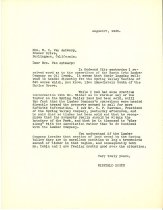Person Record
Metadata
Name |
Hopkins, Timothy |
Notes |
Timothy Hopkins was a good friend of Leland Stanford, and was involved with his University. He is the one who established the Hopkins Marine Station in Monterey for Stanford University. Timothy was born in Maine and brought to California by his gold seeking family. His father died, and his mother became employed in the home of childless Mark Hopkins. Timothy was raised in the household, but never adopted until after the death of Mark Hopkins. Mrs. Hopkins adopted him at a fairly late age in 1879, and he married the niece of his adopted mother a few years later. Mrs. Hopkins purchased the Menlo Park estate and gave it to the couple as a wedding gift. Timothy and his wife lived in San Francisco but summered in Menlo Park at the estate they now called Sherwood Hall. It was badly damaged in the earthquake of 1906 and Hopkins shut it down. He died in 1936, and willed the estate to Stanford University. During World War II the US Army acquired the property to use as a hospital. Most of the buildings were demolished, as they were uninhabitable. Pieces were auctioned off. Universal Studios bought the disassembled mansion to use in movie sets. The Menlo Park Civic Center now sits on part of the property. Only the gatehouse from the original estate in Menlo Park still stands. It was part of the construction done in 1864 by Barron. It is one of the last reminders of that era of grand homes and is listed in the National Register of Historic Places. Milton S. Latham had built Thurlow Lodge in 1872 after he bought the estate from W. E. Barron. Barron originally had a 280-acre place with several outbuildings and a 40-room mansion. He had built there in 1864 when the completion of the San Francisco to San Jose railroad opened up the Peninsula to commute traffic. One of the objects of art on display at the de Young Museum in San Francisco is a mantel that was taken from Thurlow Lodge in Menlo Park. According to the information at the museum, Herter Brothers in New York did the design and the firm of Guéret Fréres of Paris did the carving. The date is given as 1872-1873. It certainly is a magnificent mantel. It appears to be about 15 feet tall and is made of wood, marble, antlers and a clock. The real antlers are mounted on a realistically carved wooden deer head. The clock is built in as an integral part of the mantel. A hunting motif is used throughout, with life size wood hounds supporting the sides. The French oak mantelpiece, according to the museum, had been in the dining room of Thurlow Lodge. It is considered a major work of American decorative art and is on public display for the first time. Apparently Timothy Hopkins had moved it and some other pieces from Menlo Park in 1928 when he moved into a new San Francisco home. It had been modified slightly to fit into the new location. Museum experts have restored it using historic photos of Thurlow Lodge that Latham commissioned to document the original home (Joan Levy 2006/2011) |
Othernames |
Timothy Nolan |
Born |
1859 |
Birthplace |
Maine |
Deceased |
Jan. 1, 1936 |
Occupation |
Railroad Executive, Businessman |
Titles & honors |
Trustee, Stanford University |
Places of residence |
Maine Sacramento Menlo Park San Francisco |
Father |
Patrick Nolan |
Mother |
Caroline Nolan; (Adopted by) Mary Francis Sherwood Hopkins |
Spouse |
Clara Crittenden |
Related Records
-
Correspondence by Winfield Scott related to the Butano Forest State Park Association - Letter
Correspondence by Winfield Scott related to the Butano Forest State Park Association, 1931-1932. The Butano Forest State Park Association's goal was, "To take such lawful measures as are deemed best by the membership of the Association, and by its officers, necessary to bring about the creation of a State Park in San Mateo County, California; and more particularly in that portion of the county generally known and described as the Butano Forest." ...
Record Type: Archive

-
Tales of Old Menlo - Cleese, John I.
Tales of Old Menlo by John I. Cleese, 1994. Menlo Park Historical Association, Menlo Park, CA. This book is about the history of Menlo Park and contains primary source autobiography, biography, and secondary source history. 96 pages
Record Type: Library

